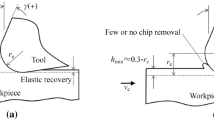Abstract
The direction vector of milling cutter for CL-data of five-axis milling is obtained by the fact that the bottom part of the milling cutter rides on free-form surfaces using the z-map method. Since the direction vector is known, CL-data can be transformed to the NC-code with regard to the geometry of the five-axis machine and post-processing. For uniform surfaces, the tool path is created from the prediction of cusp heights. After generating the NC-code, a sculptured surface was machined by five-axis end milling and cusp heights on the machined surface were measured by a three-dimensional CMM with laser scanner. From this machining test, it was found that this machining method is effective.
Similar content being viewed by others
Abbreviations
- P CC :
-
the position vector of the cc-point
- X G-Y G-Z G :
-
global coordinate
- X T-Y T-Z T,X C-Y C-Z C :
-
local coordinate on work table and spindle
- P XYZc-P XYZg :
-
the position vector of the bottom plane of the end mill cutter with respect of theX C-Y C-Z C coordinate andX G-Y G-Z G coordinate
- P C,P T :
-
the pivot point vector in the spindle and work table
- A,B,C :
-
swivel movements in NC-code,
- R,L t :
-
cutter radius,mm, and cutter length,mm
- L C :
-
the pivot distance from the gage line to the pivot point in spindle,mm
- L T :
-
the pivot distance from the work table to the pivot point in work table,mm
- f. S:
-
feedrate at cc-point,mm/min, and rotation speed of cutter,rpm
References
Cincinnati Milacron Marketing Company, 1989,Programming Manual for CINCINNATI MILACRON 20V & 30V Series Vertical 5-Axis Machines Publication No. 6-RR-87192, Part No. 3359651, U.S.A.
Idemura, T. et al, 1991, “Machining and Grinding by 5-Axis Control Machining Center-For the Workpiece with Convex Sculptured Surface,”Japanese Society of Precision Engineering (JSPE), (in Japanese) Vol. 57, No. 11, pp. 99–104.
Kishinami, T. et al, 1989, “Computer-Controlled 5-Axis Machine Tool Based on Trochoidal Interpolation,”JSPE, Vol. 55, No. 3, pp. 123–128.
Mason, F., 1991, “5×5 for High-productivity Airfoil Milling,”American Machinist, November, pp. 37–39.
narahara, H. et al, 1991, “A Study on a 5-axis Machine Tool for Sculptured Surface Having a Fixed Point in the Tip of the Tool,”JSPE, Vol. 57, No. 7, pp. 63–68.
Rüegg, A, 1992, “A Generalized Kinematics Model for Three- to Five-Axis Milling Machines and Their Implementation in a CNC,”Annals of the CIRP, Vol. 41, No. 1, pp. 547–550.
Tönshoff, H. K. and Hernandez Camacho, 1989, “Die Manufacturing by 5-Axis and 3-Axis Milling (Influence of Surface Shape on Cutting Conditions),”J. of Mechanical Working Technology Vol. 20, pp. 105–119.
Takeuchi, Y.: et al, 1990, “5-Axis Control Machining Based on Solid Model,”JSPE, Vol. 56, No. 11, pp. 111–116.
Takeuchi, Y. et al, 1992A, “Generation of 5-Axis Control Collision-Free Tool Path and Post-processing for NC Data,”Annals of the CIRP, Vol. 41, No. 1, pp. 539–542.
Takeuchi, Y. et al, 1992B, “Study on Post-processor for 5-Axis Control Machining Centers,”JSPE, Vol. 58, No. 9, pp. 128–134.
Vickers, G. W. et al, 1989, “Ball-Mills Versus End-mills for Curved Surface Machining,”J. of Eng. for Industry (Trans. of the ASME), Vol. 111, February, pp. 22–26.
Author information
Authors and Affiliations
Rights and permissions
About this article
Cite this article
Cho, H.D., Yang, M.Y. A study on the five-axis end milling for sculptured surfaces. KSME Journal 9, 428–437 (1995). https://doi.org/10.1007/BF02953641
Received:
Issue Date:
DOI: https://doi.org/10.1007/BF02953641




